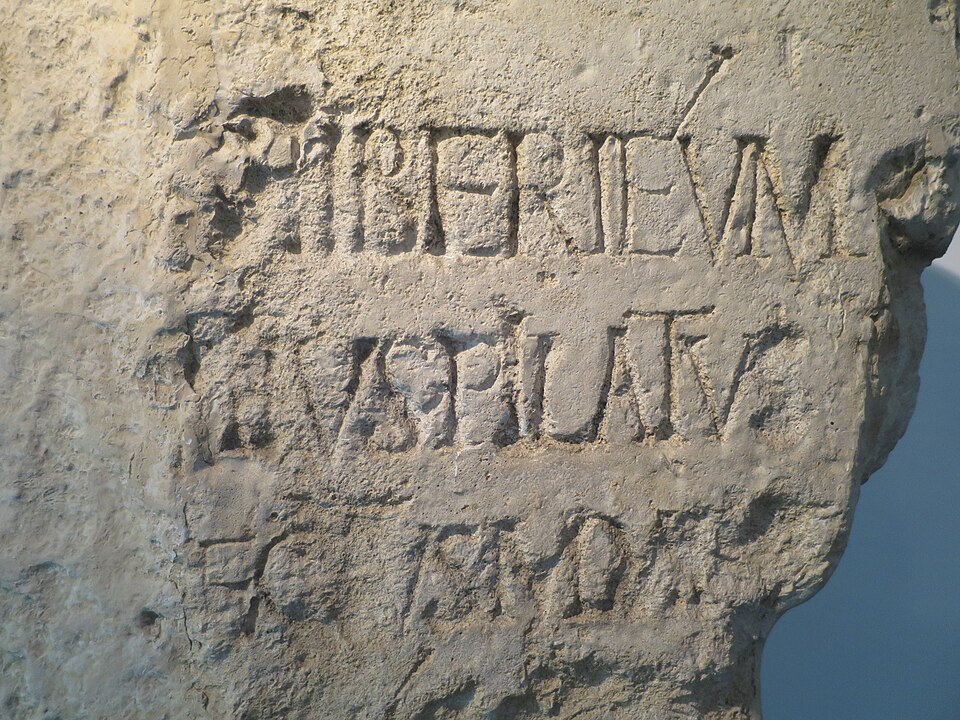
The Pilate Stone
🏛️ Introduction
The Pilate Stone is a landmark archaeological discovery that provides concrete evidence of Pontius Pilate and his role as the Roman prefect (governor) of Judea during the early 1st century AD. Discovered in 1961 at Caesarea Maritima, this limestone block bears a Latin inscription explicitly naming “Pontius Pilatus,” confirming historical details that align with New Testament accounts.
Among archaeological finds associated with Pilate, the Pilate Stone stands out as the most definitive and historically significant artifact, providing the clearest direct evidence of his governorship, while other discoveries, such as the Pilate Ring, offer additional but less certain support. This tangible evidence complements extra-biblical sources, such as Josephus and Tacitus, which record that Jesus was crucified under Pilate’s authority, reinforcing the historical reliability of the Gospel narratives.
🏺Discovery and Description
In June 1961, Italian archaeologist Maria Teresa Fortuna Canivet uncovered the Pilate Stone during excavations near the ancient theater built by Herod the Great in Caesarea Maritima. The stone was originally part of a dedicatory inscription to the emperor Tiberius. It was later repurposed in the 4th century as a building block for a set of stairs behind the stage house of the Herodian theater .
✍️ Inscription and Translation
The inscription on the Pilate Stone is partially preserved, with several lines remaining legible. The Latin text reads:
[DIS AUGUSTI]S TIBERIÉUM
[…PONTI]US PILATUS
[…PRAEF]ECTUS IUDA[EA]E
[…FECIT D]E[DICAVIT]
Which translates to:
“To the Divine Augusti [this] Tiberieum
…Pontius Pilate
…Prefect of Judea
…has dedicated [this]”
The term “Tiberieum” likely refers to a structure dedicated to Emperor Tiberius, possibly a temple or public building.
📜 Historical Significance
The Pilate Stone is the most significant archaeological artifact discovered to date that directly mentions Pontius Pilate by name. While Pilate is referenced in historical writings by Josephus, Philo, and Tacitus, these sources were written after his tenure. The Pilate Stone provides contemporary, physical evidence of his existence and position, aligning with Gospel accounts of his involvement in Jesus’ trial and crucifixion. Its discovery demonstrates that Pilate was indeed the Roman prefect of Judea, cementing the historical context of the New Testament events and directly addressing any skepticism regarding his historical existence.
🪙 Other Pilate Artifacts
In addition to the Pilate Stone, other artifacts potentially linked to Pontius Pilate include the Pilate Ring, a copper-alloy sealing ring bearing the inscription “Pilate,” and Pilate’s prutah coins, minted in Jerusalem during his governorship. For more detailed information on these discoveries and their historical context, see Pontius Pilate: An Archaeological Biography, a reliable resource recommended for further reading.
🎓 Scholarly Consensus
The authenticity of the Pilate Stone is universally accepted among scholars. Its location in Caesarea Maritima, the administrative capital of Roman Judea during Pilate’s governorship, strengthens its credibility. The inscription’s reference to Pilate as “Prefect of Judea” is consistent with historical records, distinguishing him from later procurators who governed the province.
🔎 Conclusion
The Pilate Stone stands as a testament to the intersection of archaeology and biblical history. Its discovery provides concrete, verifiable evidence of Pontius Pilate’s role in Roman governance and supports the historical reliability of the New Testament, particularly regarding the trial and crucifixion of Jesus. Together with textual accounts from Josephus and Tacitus, the Pilate Stone highlights how archaeology can corroborate and highlight key figures and events described in the Gospels.
📚 References
- Madain Project, Pilate Inscription Stone.
- Bible Archaeology Report, Pontius Pilate: An Archaeological Biography.
- Pilate Stone — Photo by Reinhard Dietrich, Wikimedia Commons, CC BY 4.0, link

Leave a Reply